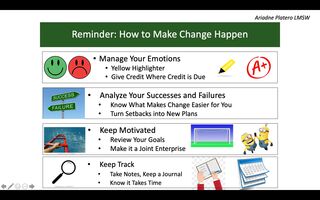Habit Formation
7 Steps of Habit Formation
How to take control and harness your habits for the change you want.
Posted November 11, 2021 Reviewed by Abigail Fagan
Key points
- It is crucial to understand yourself and your current habits before attempting to alter them.
- Planning for your needs and directly replacing old habits is integral to making new habits stick.
- Habit formation is easier when you focus on one target change, create reminders, and recruit support.
Much of what I’ve been writing about in this Reflect and Reset series has been about taking the opportunity — or, in many cases, making the opportunity to — think about different aspects of our lives and how to take control and make changes. Even for those who are fairly content with the direction of their lives, reflection can trigger a desire to change something. That might be a major change at the macro level, such as the overall direction of our career, our sense of purpose, our family or social life, or a smaller shift at the micro level, like broadening our approach to fitness, starting a project we’ve long been circling, or drinking less coffee.
Deciding to make a change means that we no longer want to be passive, letting inertia or outside circumstances determine our actions or lack thereof.
There are times when these changes are relatively easy. We just needed to focus on what was going on or what was missing, and we create a shift. Other times, we’re battling legions of ingrained habits that are holding us in old patterns of behavior, stuck in a groove and unable to break out.
In my last post, we looked at executive functioning skills sets. One of the things we discussed is that when we’re young, we have greater plasticity in our brains and, thus, a greater capacity to change in a shorter timeframe. Good news for the under-thirties — habit change is going to be easier for you. But, and this is the key, even those of us who are no longer in the flush of young adulthood can still make those changes and shift those habits. With focus and drive, we can break down old habits and teach ourselves new ones if we have both the motivation and the determination to do so.
As usual, I like to turn to logic, information, and structure to help us understand how we can make desired habit changes. It helps to understand that, sophisticated though we may like to think we are, we are really quite simple creatures. There’s a passage in the excellent book The Power of Habit by Charles Duhigg which memorably describes a situation in which an individual wanting to increase the frequency of their early morning runs merely has to leave their shoes out the night before to radically increase their chances of actually going out to run the next morning. Pretty basic. But it is this very simplicity that works in our favor if we’re disciplined about how we deploy it. This is where the structure comes in:

First, we have to define our targets for change. As an example, let’s stick with the target of an improved exercise routine and be specific about our goal: working out four times a week.
Second, we’re going to focus on the process of habit changing: We must identify our positive and negative habits around exercise. What are the things that support our good exercise habits and what are the approaches that make us less effective? Think about taking a red pen and a yellow highlighter to all the details around exercise. The red pen is critiquing the negative habits we should be eliminating — not scheduling our runs at a specific time, not having our workout clothes ready. The yellow highlighter is for underscoring the good habits we sometimes deploy, so we can use them more regularly and give credit for the things we’re doing right — setting a reminder on our phones, recruiting a friend to exercise with.
Third, we must create replacement habits. It is easier to stop doing something if you put a replacement habit in its stead. For example, if you’re trying to cut down on your coffee intake, plan ahead so that when you have an urge for another cup of coffee, you will, instead, pour yourself a glass of water or head out for a brief walk. Sitting at your desk and thinking about the coffee you can’t have just makes things hard for yourself but taking charge and inserting a different activity when you would normally have that coffee makes for an easier transition to the desired behavior.

Fourth, develop reinforcing review rituals and manage your emotions. Review your goals and targeted habits regularly. At night, check in with yourself about how the day went. If it went according to plan, note what made it good and give yourself credit for it. If not, note what you could do differently to ensure greater success tomorrow. In the morning, set a new intention for the day ahead, and remind yourself you can do it.
Fifth, be alert to the dangers of relapse. Successful habit change depends on the effectiveness of our motivation, but also on our ability to break the hold of old habits. Even when we think we’ve created lasting change, we are often one highly stressful situation away from relapse. Stress is insidious, lowering our resistance and undermining our willpower. Be aware of when stress is likely to emerge and manage your emotions throughout the process.
And surround yourself with reminders. Deploy multiple Post-it notes adorned with the target change, your motivation, the predictable pitfalls, and reminders of the expected benefits of change. Co-opt your friends, too. Ask them to check in with you and ask if you can be in touch when your willpower wobbles.

As a final tip, pick just one habit to change first. Make things easy for yourself and don’t clutter up your mental desk. If you have competing goals and target habits, it’s harder to effectively change any of them as priorities get muddled. Focus on just one. When that is achieved, then choose the next one.
To sum up:
- Define a Single Specific Target Change
- Identify Existing Habits
- Create Replacement Habits
- Develop Reinforcing Review Rituals
- Manage your Emotions
- Have a Relapse Plan
- Rinse and Repeat
References
Duhigg, Charles (2012) The Power of Habit. Random House




